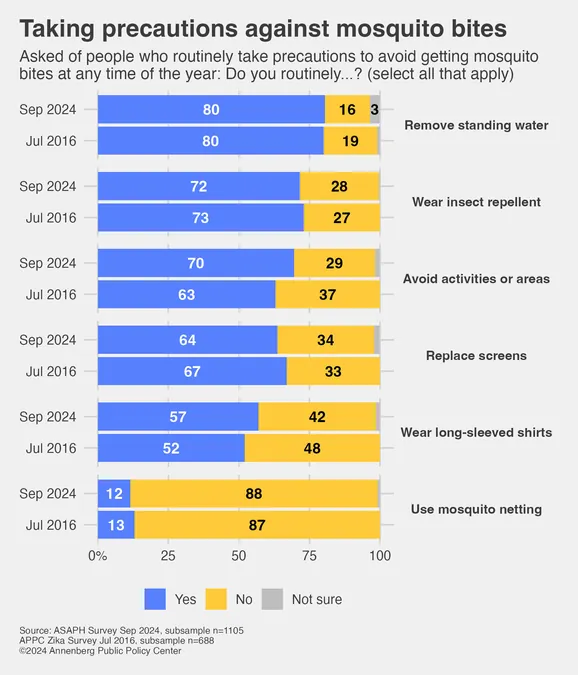
Beware! The Rising Threat of Mosquito-Borne Illnesses in a Warming World
2024-10-08
Author: Wei
As our planet continues to warm, the threat from mosquito-borne diseases has never been more urgent. The alarming hospitalization of Dr. Anthony Fauci last summer due to West Nile virus has reignited public concern about illnesses spread by these pesky insects. In a recent article in the New York Times, he shared his firsthand experience, helping to bring greater awareness to serious diseases that include Zika, malaria, dengue, and the West Nile virus.
According to the Centers for Disease Control and Prevention (CDC), the impact of climate change is evident in the patterns of mosquito populations. Milder winters, earlier springs, and higher temperatures are creating more favorable conditions for mosquitoes and ticks to thrive, thereby increasing the chances of disease transmission. In fact, as of October 1, there have been 880 reported cases of West Nile virus in the United States this year, reinforcing its status as the most prevalent mosquito-borne viral disease in the country.
Just this month, California public health officials issued a stark warning about an “unprecedented” outbreak of dengue fever. Additionally, an alarming incident in August involved a New Hampshire man who succumbed to Eastern equine encephalitis (EEE), underscoring the dangers lurking closer to home. CNN highlighted this summer as a particularly alarming period filled with warnings regarding various mosquito-borne illnesses.
However, despite these rising threats, a recent health knowledge survey conducted by the Annenberg Public Policy Center (APPC) revealed that only 15% of Americans believe they or their families are at risk of contracting dengue or West Nile virus in the near future. This disconnect indicates a troubling gap in public awareness and understanding of these risks. Kathleen Hall Jamieson, director of APPC, emphasized that mosquitoes causing serious illnesses may be more common than people realize, often found not in exotic locales but in our own backyards.
Key Findings on Awareness and Prevention
The survey found that while nearly three-quarters of respondents (74%) are aware that an infected Aedes mosquito is the primary vector for diseases like dengue and West Nile, many were misinformed about how these viruses can be transmitted. For instance, a significant percentage believed that someone could contract these viruses through sneezing or coughing, despite CDC guidance stating that transmission occurs only via mosquito bites.
Awareness of West Nile symptoms fell short as well, with less than half of participants correctly identifying the CDC-recognized symptoms such as fever (42%), muscle and joint pain (37%), and headache (36%). Alarmingly, many respondents mistakenly attributed non-related symptoms to West Nile virus.
Furthermore, the survey indicated limited understanding of advanced mosquito control measures being implemented globally. While scientists are using genetically modified (GM) mosquitoes to combat populations in countries like Brazil and India, many people remain unsure about their efficacy and safety, with nearly half of those surveyed expressing uncertainty about the impacts of these technologies.
Preventive Measures and Public Knowledge Gaps
Fortunately, awareness of preventive measures remains relatively high. Nearly 79% of survey participants recognize that the best defense against these viruses is to prevent mosquito bites and control their populations around homes. Nevertheless, there remains a surprising lack of knowledge regarding current treatment options—most (62%) were unsure that there is no antiviral treatment specifically for dengue or West Nile.
The reality is that many individuals seem less vigilant in taking proactive precautions against mosquito bites compared to previous years, with only 59% reporting that they routinely take measures to protect themselves — down from 67% during the Zika outbreak in 2016.
Effective strategies to stay safe include removing standing water (practiced by 80% of those surveyed), using insect repellent (72%), and avoiding mosquito-rich areas (70%). Yet, there remains a need for education, especially regarding the correct application of insect repellent and sunscreen, and the importance of consulting the CDC’s guidelines on safe practices, particularly for infants and young children.
Conclusion: Increasing Public Education is Crucial
In light of these findings, public health officials stress the importance of enhancing education about mosquito-borne diseases and how to prevent them. As the climate continues to change, making informed decisions and taking preventive steps can be vital in safeguarding ourselves and our communities from the threats that mosquitoes pose.
With mosquito-borne illnesses on the rise, the time to act is now. Ensure you’re informed, stay proactive, and protect yourself and your family from these unexpected dangers that could be lurking right outside your door!


 Brasil (PT)
Brasil (PT)
 Canada (EN)
Canada (EN)
 Chile (ES)
Chile (ES)
 España (ES)
España (ES)
 France (FR)
France (FR)
 Hong Kong (EN)
Hong Kong (EN)
 Italia (IT)
Italia (IT)
 日本 (JA)
日本 (JA)
 Magyarország (HU)
Magyarország (HU)
 Norge (NO)
Norge (NO)
 Polska (PL)
Polska (PL)
 Schweiz (DE)
Schweiz (DE)
 Singapore (EN)
Singapore (EN)
 Sverige (SV)
Sverige (SV)
 Suomi (FI)
Suomi (FI)
 Türkiye (TR)
Türkiye (TR)